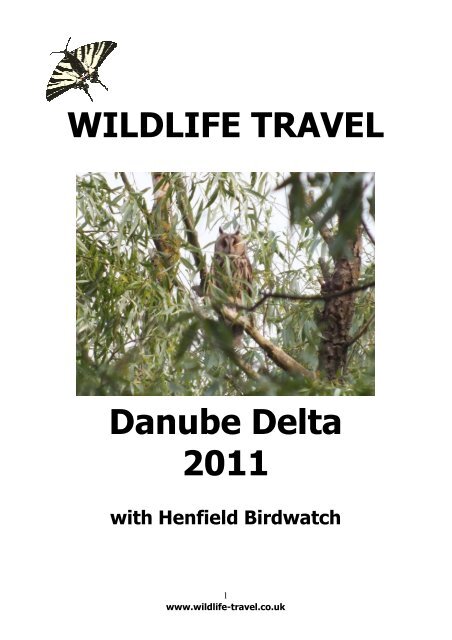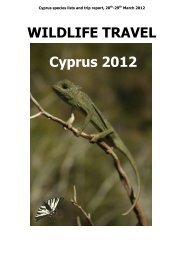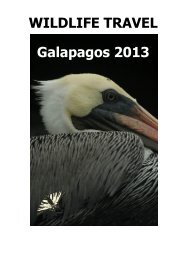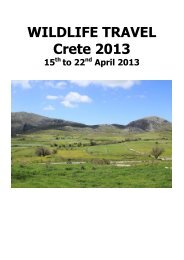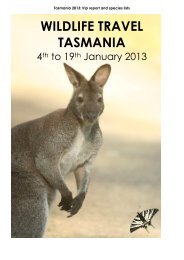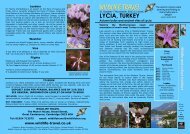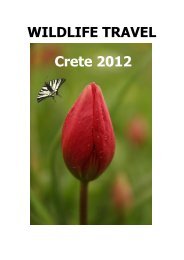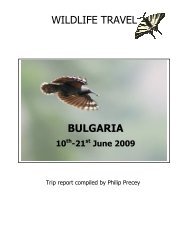Create successful ePaper yourself
Turn your PDF publications into a flip-book with our unique Google optimized e-Paper software.
WILDLIFE TRAVEL<br />
Danube Delta<br />
<strong>2011</strong><br />
with Henfield Birdwatch<br />
1<br />
www.wildlife-travel.co.uk
# DATE LOCATIONS & NOTES<br />
1 12 th <strong>May</strong> Bucharest Airport to Hotel Diament, Amara<br />
2 13 th <strong>May</strong> Amara Fishponds, Sraraeu Lake, Babadag Forest, Lake Murighoil, Uzlina<br />
3 14 th <strong>May</strong> Lakes Uzlina, Cabloalca, Bojarnia, Duraleapa & Isaccel<br />
4 15 th <strong>May</strong> Uzlina to Sfantu Gheorghe<br />
5 16 th <strong>May</strong> Sacalin Island and Sfantu Gheorghe<br />
6 17 th <strong>May</strong> Sfantu Gheorghe to Dunaeat<br />
7 18 th <strong>May</strong> Dunaeat to Dranov and back<br />
8 19 th <strong>May</strong> Dunaeat and Lakes Perivolovca, Taranova & Gorgostel then to Uzlina<br />
9 20 th <strong>May</strong> Uzlina- Nufal – Machin Hills – to Amara<br />
10 21 st <strong>May</strong> Amara to Bucharest, People's Palace and Historv Buildings Museum<br />
<strong>Travel</strong>lers: Nigel and Debbie Colgate, David and Greta Coleman, Gordon and Sylvia Bain,<br />
Graham and Liz Smith, Celia Beresford and John Gardner, Val Bentley, Sallie Bedford<br />
Pat Dunderdale, Will Green<br />
Leaders: Calin Hodor & Cosmin (EuroDelta), Mike Russell (<strong>Wildlife</strong> <strong>Travel</strong>)<br />
Outside the People's Palace - Greta<br />
2<br />
www.wildlife-travel.co.uk
Cruising down the Dranov Channel - Gordon<br />
3<br />
www.wildlife-travel.co.uk<br />
Relaxing… but not for long! - Val<br />
Invading Sacalin Island - Gordon
Purple Heron - Graham<br />
Roller - Graham<br />
Paddyfield Warbler - Graham<br />
Great Reed Warbler - Graham<br />
4<br />
www.wildlife-travel.co.uk
ENGLISH NAME<br />
Danube Delta, species list and trip report, 12 th to 21 st <strong>May</strong> <strong>2011</strong><br />
LATIN NAME<br />
5<br />
www.wildlife-travel.co.uk<br />
12 th<br />
13 th<br />
Family Podicipedidae (Grebes)<br />
Little Grebe Tachybaptus ruficollis •<br />
14 th<br />
15 th<br />
16 th<br />
17 th<br />
18 th<br />
19 th<br />
Black-necked Grebe Podiceps nigricollis • • • •<br />
Great Crested Grebe Podiceps cristatus • • • • • •<br />
Red-necked Grebe Podiceps grisegena • •<br />
Family Pelecanidae (Pelicans)<br />
White Pelican Pelecanus onocrotalus • • • • • • •<br />
Dalmatian Pelican Pelecanus crispus • • • • •<br />
Family Phalacrocoracidae (Cormorants)<br />
Cormorant Phalacrocorax carbo • • • • • • • • •<br />
Pygmy Cormorant Phalacrocorax pygmeus • • • • • • • •<br />
Family Ardeidae (Herons)<br />
Bittern Botaurus stellaris H H H<br />
Little Bittern Ixobrychus minutus • •<br />
Night Heron Nycticorax nycticorax • • • • • • • • •<br />
Little Egret Egretta garzetta • • • • • • • • •<br />
Great White Egret Egretta alba • • • • • • • •<br />
Squacco Heron Ardeola rolloides • • • • • • • •<br />
Grey Heron Ardea cinerea • • • • • • • • •<br />
Purple Heron Ardea purpurea • • • • • • • •<br />
Family Ciconiidae (Storks)<br />
White Stork Ciconia ciconia • • • • • • • • • •<br />
Family Threskiornithidae (Ibises and Spoonbills)<br />
Glossy Ibis Plegadis falcinellus • • • • • • • •<br />
Spoonbill Platalea leucorodia • •<br />
Family Anatidae (Ducks, Geese and Swans)<br />
Mute Swan Cygnus olor • • • • • • • • •<br />
Greylag Goose Anser anser • • • • • • • •<br />
Shelduck Tadorna tadorna • • • • • • •<br />
Ruddy Shelduck Tadorna ferruginea •<br />
Mallard Anas platyrhynchos • • • • • • • • •<br />
Gadwall Anas strepera • • • • •<br />
Shoveler Anas clypeata •<br />
Garganey Anas querquedula • •<br />
Red-crested Pochard Netta rufina • •<br />
Pochard Aythya ferina • • • • • • • •<br />
Ferruginous Duck Aythya nyroca • • • • • • • • •<br />
Family Accipitridae (Hawks, Eagles and Vultures)<br />
White-tailed Eagle Haliaeetus albicilla • • • • • •<br />
Lesser Spotted Eagle Aquila pomarina •<br />
Marsh Harrier Circus aeruginosus • • • • • • • • •<br />
Common Buzzard Buteo buteo • •<br />
Honey Buzzard Pernis apivorus •<br />
Levant Sparrowhawk Accipiter brevipes •<br />
Family Falconidae (Falcons)<br />
Kestrel Falco tinnunculus • • • • • • • • •<br />
Red-footed Falcon Falco vespertinus • • • • • • • •<br />
Hobby Falco subbuteo • • • • • • • • • •<br />
Family Phasianidae (Pheasants and Partridges)<br />
Pheasant Phasianus colchicus • • H H • • H •<br />
Grey Partridge Perdix perdix •<br />
20 th<br />
21 st
ENGLISH NAME<br />
Danube Delta, species list and trip report, 12 th to 21 st <strong>May</strong> <strong>2011</strong><br />
LATIN NAME<br />
6<br />
www.wildlife-travel.co.uk<br />
12 th<br />
13 th<br />
14 th<br />
15 th<br />
16 th<br />
17 th<br />
18 th<br />
19 th<br />
Family Rallidae (Rails and Crakes)<br />
Moorhen Gallinula chloropus • • • • • • • •<br />
Coot Fulica atra • • • • • • • •<br />
Family Recurvirostridae (Stilts and Avocets)<br />
Avocet Recurvirostra avosetta • • • • • •<br />
Black-winged Stilt Himantopus himantopus • • •<br />
Family Haematopodidae (Oystercatchers)<br />
Oystercatcher Haematopodus ostralegus •<br />
Family Charadriidae (Plovers)<br />
Little Ringed Plover Charadrius dubius •<br />
Kentish Plover Charadrius alexandrinus •<br />
Grey Plover Pluvialis squatarola •<br />
Lapwing Vanellus vanellus • • • • • • • •<br />
Family Scolopacidae (Sandpipers)<br />
Dunlin Calidris alpina •<br />
Curlew Sandpiper Calidris ferruginea • •<br />
Little Stint Calidris minuta •<br />
Green Sandpiper Tringa ochropus • •<br />
Turnstone Arenaria interpres •<br />
Spotted Redshank Tringa erythropus •<br />
Greenshank Tringa nebularia •<br />
Common Sandpiper Actitis hypoleucos • • •<br />
Black-tailed Godwit Limosa limosa •<br />
Curlew Numenius arquata •<br />
Whimbrel Numenius phaecopus •<br />
Ruff Philomachus pugnax •<br />
Family Laridae (Gulls)<br />
Black-headed Gull Larus ridibundus • • • • • • • • •<br />
Mediterranean Gull Larus melanocephalus • • • •<br />
Great Black-headed Gull Larus ichthyaetus • • • •<br />
Caspian Gull Larus cachinnans • • • • • • • • • •<br />
Yellow-legged Gull Larus michahellis •<br />
Little Gull Larus minutus •<br />
Family Stercorariidae (Skuas)<br />
Pomarine Skua Stercocorarius pomarinus •<br />
Family Sternidae (Terns)<br />
Little Tern Sterna albifrons •<br />
Sandwich Tern Sterna sandvicensis •<br />
Gull-billed Tern Sterna nilotica •<br />
Common Tern Sterna hirundo • • • • • • • • •<br />
Caspian Tern Sterna caspia •<br />
Black Tern Chlidonias niger • • • • • • •<br />
White-winged Black Tern Chlidonias leucopterus •<br />
Whiskered Tern Chlidonias hybridus • • • • • • • • •<br />
Family Columbidae (Pigeons and Doves)<br />
Rock Dove/Feral Pigeon Columba livia • • • • • • • • • •<br />
Stock Dove Columba oenas • • H<br />
Woodpigeon Columba palumbus • • • • • •<br />
Collared Dove Streptopelia decaocto • • • • • • • • • •<br />
Turtle Dove Streptopelia turtur • • • • •<br />
Family Cuculidae (Cuckoos)<br />
Cuckoo Cuculus canorus • • • • • • • • •<br />
20 th<br />
21 st
ENGLISH NAME<br />
Danube Delta, species list and trip report, 12 th to 21 st <strong>May</strong> <strong>2011</strong><br />
LATIN NAME<br />
7<br />
www.wildlife-travel.co.uk<br />
12 th<br />
13 th<br />
14 th<br />
15 th<br />
16 th<br />
17 th<br />
18 th<br />
19 th<br />
Family Strigidae (Owls)<br />
Tawny Owl Strix aluco H H H H H H<br />
Little Owl Athene noctua •<br />
Long-eared owl Asio otus • • •<br />
Family Caprimulgidae (Nightjars)<br />
Nightjar Caprimulgus europaeus •<br />
Family Apodidae (Swifts)<br />
Swift Apus apus • • • • •<br />
Family Upupidae (Hoopoes)<br />
Hoopoe Upupa epops • • • • • • • • •<br />
Family Alcedinidae (Kingfishers)<br />
Kingfisher Alcedo atthis • • • • •<br />
Family Meropidae (Bee-eaters)<br />
Bee-eater Merops apiaster • • • • • • • •<br />
Family Coraciidae (Rollers)<br />
Roller Coracias garrulus • • • • • • • • •<br />
Family Picidae (Woodpeckers)<br />
Black Woodpecker Dryocopus martius • •<br />
Grey-headed Woodpecker Picus canus • • • • •<br />
Great Spotted Woodpecker Dendrocopos major • • • • • • •<br />
Syrian Woodpecker Dendrocopos syriacus •<br />
Lesser Spotted Woodpecker Dendrocopos minor H • • H<br />
Wryneck Jynx torquilla •<br />
Family Alaudidae (Larks)<br />
Skylark Alauda arvensis • •<br />
Woodlark Lullula arborea •<br />
Calandra Lark Melanocorypha calandra • •<br />
Family Hirundinidae (Swallows and Martins)<br />
Sand Martin Riparia riparia • • • • • •<br />
Swallow Hirundo rustica • • • • • • • • • •<br />
Red-rumped Swallow Hirundo daurica •<br />
House Martin Delichon urbica • • • • •<br />
Family Motacillidae (Wagtails and Pipits)<br />
White Wagtail Motacilla (alba) alba • • • • • • • • •<br />
Black-headed Wagtail Motacilla (flava) feldegg • • •<br />
‘Romanian’ Yellow Wagtail Motacilla (flava) dombroskii • •<br />
20 th<br />
21 st<br />
Family Turdidae (Thrushes and Chats)<br />
Nightingale Luscinia megarhynchos H H • • H H<br />
Thrush Nightingale Luscinia luscinia • H • H • H<br />
Redstart Phoenicurus phoenicurus • • • • • •<br />
Northern Wheatear Oenanthe oenanthe • •<br />
Isabelline Wheatear Oenanthe isabellina •<br />
Pied Wheatear Oenanthe pleschanka •<br />
Whinchat Saxicola rubetra • • •<br />
(Rufous-tailed) Rock Thrush Monticola saxatilis •<br />
Blackbird Turdus merula • • • • • •<br />
Family Sylviidae (Warblers)<br />
Garden Warbler Sylvia borin H • • • H •<br />
Blackcap Sylvia atricapilla • • • • H<br />
Lesser Whitethroat Sylvia curruca • • • • H<br />
Whitethroat Sylvia communis •<br />
Sedge Warbler Acrocephalus schoenobaenus • H<br />
H H
ENGLISH NAME<br />
Danube Delta, species list and trip report, 12 th to 21 st <strong>May</strong> <strong>2011</strong><br />
LATIN NAME<br />
8<br />
www.wildlife-travel.co.uk<br />
12 th<br />
13 th<br />
14 th<br />
15 th<br />
16 th<br />
17 th<br />
Paddyfield Warbler Acrocephalus agricola •<br />
18 th<br />
19 th<br />
Reed Warbler Acrocephalus scirpaceus • H H • • H H H •<br />
Marsh Warbler Acrocephalus palustris • H H H H H<br />
Great Reed Warbler Acrocephalus arundinaceus H H H H H H H<br />
Savi’s Warbler Locustella luscinioides • H H H H H H<br />
Icterine Warbler Hippolais icterina •<br />
Chiffchaff Phylloscopus collybita • • H H • H H<br />
Willow Warbler Phyllooscopus trochilus • H • H<br />
Family Muscicapidae (Flycatchers)<br />
Spotted Flycatcher Muscicapa striata • • • • • • • •<br />
Collared Flycatcher Ficedula albicollis •<br />
Family Paridae (Tits)<br />
Great Tit Parus major • • • • • • • • •<br />
Blue Tit Parus caeruleus • • • • • • • • •<br />
Family Aegithalidae (Long-tailed Tits)<br />
Long-tailed Tit Aegithalos caudatus • •<br />
20 th<br />
21 st<br />
Family Panuridae (Bearded Tit)<br />
Bearded Tit Panurus biarmicus • • H<br />
Family Certhiidae (Treecreepers)<br />
Short-toed Treecreeper Certhia brachydactyla • • •<br />
Family Laniidae (Shrikes)<br />
Red-backed Shrike Lanius collurio • • • • • •<br />
Lesser Grey Shrike Lanius minor • • • • • • • •<br />
Family Corvidae (Crows)<br />
Magpie Pica pica • • • • • • • • • •<br />
Jay Garrulus glandarius • •<br />
Jackdaw Corvus monedula • • • • • • • •<br />
Rook Corvus frugilegus • • • •<br />
Hooded Crow Corvus cornix • • • • • • • • • •<br />
Family Sturnidae (Starlings)<br />
Starling Sturnus vulgaris • • • • • • • • • •<br />
Family Oriolidae (Orioles)<br />
Golden Oriole Oriolus oriolus • • • • • • • H<br />
Family Passeridae (Sparrows)<br />
House Sparrow Passer domesticus • • • • • • • • • •<br />
Spanish Sparrow Passer hispaniolensis • •<br />
Tree Sparrow Passer montanus • • • • • • • •<br />
Family Fringillidae (Finches)<br />
Chaffinch Fringilla coelebs • H • • • H •<br />
Goldfinch Carduelis carduelis • • • • • • • •<br />
Greenfinch Carduelis chloris • H<br />
Family Emberizidae (Buntings)<br />
Reed Bunting Emberiza schoeniclus • • • • •<br />
Ortolan Bunting Emberiza hortulana •<br />
Corn Bunting Miliaria calandra • •
ENGLISH NAME<br />
Danube Delta, species list and trip report, 12 th to 21 st <strong>May</strong> <strong>2011</strong><br />
LATIN NAME<br />
9<br />
www.wildlife-travel.co.uk<br />
12 th<br />
13 th<br />
14 th<br />
15 th<br />
AMPHIBIANS<br />
Frogs and Toads<br />
Fire-bellied Toad Bombina bombina H<br />
16 th<br />
17 th<br />
18 th<br />
19 th<br />
Green Toad Bufo viridis •<br />
Marsh Frog Rana ridibunda • • • • • • • • • •<br />
REPTILES<br />
Tortoises and Terrapins<br />
European Pond Terrapin Emys orbicularis •<br />
Lizards<br />
Balkan Green Lizard Lacerta trilineata •<br />
Balkan Wall Lizard Podarcis taurica • •<br />
Snake-eyed Skink Ablepharus kitaibelii •<br />
Snakes<br />
Grass Snake Natrix natrix • •<br />
Dice Snake Natrix tessellata • •<br />
MAMMALS<br />
Larger Mammals<br />
Golden Jackal Canis aureus •<br />
Red Fox Vulpes vulpes •<br />
Roe Deer Capreolus capreolus •<br />
Brown Hare Lepus europaeus •<br />
European Souslik Spermophilus citellus •<br />
Brown Rat Rattus norvegicus •<br />
BUTTERFLIES<br />
Scarce Swallowtail Iphiclides podalirius<br />
Southern Festoon Zerytnthia polyxena<br />
Glanville Fritillary Melitaea cinxia<br />
Red Admiral Vanessa atalanta<br />
Selected Plant Species<br />
SCIENTIFIC NAME<br />
Anacardiaceae<br />
ENGLISH NAME<br />
Cotinus coggygria Smoke Bush<br />
Asparagaceae<br />
Muscari comosum Tassel Hyacinth<br />
Boraginaceae<br />
Cerinthe minor Lesser Honeywort<br />
Lithospermum purpurocaerulea Purple Gromwell<br />
Euphorbiaceae<br />
Euphorbia cyparissus Cypress Spurge<br />
Euphorbia palustris Marsh Spurge<br />
Iridaceae<br />
Iris pumila Dwarf Iris<br />
Lamiaceae<br />
Ajuga chamaepitys Ground Pine Babadag: yellow flowers<br />
Orchidaceae<br />
Orchis purpurea Lady Orchid Babadag: very tall, darker<br />
Orchis simia Monkey Orchid Babadag: smaller, paler<br />
Notes<br />
20 th<br />
21 st
Danube Delta, species list and trip report, 12 th to 21 st <strong>May</strong> <strong>2011</strong><br />
SCIENTIFIC NAME<br />
Paeoniaceae<br />
ENGLISH NAME<br />
Paeonia peregrina The large red paeony, Babadag<br />
Primulaceae<br />
Lysimachia nummularia Creeping Jenny<br />
Ranunculaceae<br />
Adonis vernalis Yellow Pheasant’s-eye<br />
Tamaricaceae<br />
Tamarix gallica French Tamarisk The pinky shrub on sandier places in the delta<br />
One of the nice things about doing the report is that, once you actually get started, it brings back<br />
some really good memories that can all to easily slip away, especially when an ageing memory<br />
comes into play. Sitting down to write this, my overwhelming sense is that it was a great trip:<br />
everything seemed to go smoothly, from leaving Henfield and other parts of Sussex, the Terminal<br />
5 experience at Heathrow made the prospect of flying almost bearable and the flights themselves<br />
were good.<br />
On arrival in Bucharest our meeting with George and Calin and transfer to the coach again all<br />
worked and throughout our time in Romania the organisation of the whole holiday was excellent<br />
and this was very much down to George and his company Eurodelta <strong>Travel</strong> who was so attentive<br />
to our needs throughout, though even he couldn't quite predict the amount of alcohol a Sussex<br />
group might enjoy!<br />
The following is my interpretation of the 10 days spent in Romania, using my notes and diary that<br />
I can't read and a memory that is starting to become unreliable so I hope it doesn't read as what<br />
can be described as 'faction'!<br />
12 th <strong>May</strong><br />
<strong>Travel</strong>ling day which, as I said, went about as smoothly as it could and not long after arriving at<br />
Otependi Airport we were on our way through the the suburbs and industrial sites of Bucharest<br />
and very much the first glimpse of the Country's post 1945 history. It was not long though before<br />
I realised what a difficult group this might be when there was an attempt to try and get a shorttoed<br />
eagle on the list as a distant raptor was spotted from the speeding coach. My resolve stayed<br />
firm and it didn't go down on the list as I was determined to set a precedent that the leader was<br />
always right… even when he tried to turn a female marsh harrier into an osprey and a common<br />
into a Caspian tern at various points in the holiday!<br />
A three-hour journey through very flat and fast developing agricultural plains eventually brought<br />
us to the Hotel Diament at Amara, a comfortable hotel but definitely not after the international<br />
tourist market and we had a first Romanian meal...eventually; but it was very nice and it gave a<br />
chance while we were waiting for a group of people, most of whom already knew each other very<br />
well, to get to know them better.<br />
13 th <strong>May</strong><br />
A hardy group assembled before breakfast for a walk around the Amara Fishponds opposite the<br />
hotel on a brilliant sunny morning and, as a leader, you dream that a holiday can start like this as<br />
we enjoyed a fantastic hour and a half's birdwatching. So good was it that Liz nominated it her<br />
most memorable moment of the trip. Immediately we were treated to wonderful close views of<br />
great reed warblers, barking at us from the top of reed stems, while soon we were looking at a<br />
10<br />
www.wildlife-travel.co.uk<br />
Notes
Danube Delta, species list and trip report, 12 th to 21 st <strong>May</strong> <strong>2011</strong><br />
very obliging night heron, the first of many ferruginous ducks while Graham's spotting of the<br />
little bittern at the edge of the reeds turned out to be his most memorable moment.<br />
Here we soon to learnt how common the cuckoo is in Romania and of the many birds seen on<br />
this walk there was two that we would not record again, little grebe and Syrian woodpecker,<br />
the latter only seen by a just few of us.<br />
An enjoyable breakfast followed by an interesting exercise in sorting out the previous night's<br />
drinks bill saw us on our way, a full day's trip to the Delta. However it was full of interesting<br />
stops, the first being at Sraraeu Lake where a short stay saw us find a couple of birds that we<br />
wouldn't see again, a pair of very colourful ruddy shelduck and a more distant lesser-spotted<br />
eagle , while a Steppe buzzard circled high overhead. A beautiful scarce swallowtail butterfly<br />
put in an appearance here as well.<br />
Back onto the bus and we were soon passing through a huge rookery with very low nests in the<br />
stunted oaks and then we had to make an emergency stop.........to photograph the white<br />
stork's nest. Our driver Mischa (?) was very considerate here in that he did put out the<br />
emergency triangle to warn other drivers of the dangerous British birdwatchers ahead. It was a<br />
very worthwhile stop because we got excellent views of the Spanish sparrows breeding in the<br />
base of the stork's nest.<br />
Then onto Babadag Forest and a wonderful couple of hours in this lovely hillside woodland, and a<br />
chance for the keen botanists to get their eye in. A feast of orchids, irises and peony amongst<br />
many others had them in raptures, well all of us really and a list of what was seen has kindly been<br />
provided by Greta and Will. This is the second list actually as the original one set a trend of<br />
objects being whisked off our floating hotel by the wind and sailing serenely down the various<br />
waters of the Danube. Your ever alert leader still had his eyes to the skies and at one point was<br />
treated to a thermal of birds above our heads containing a flock of bee-eaters, a honey<br />
buzzard (our only one) and a Levant sparrowhawk, my bird of the trip, while everyone<br />
enjoyed the close views of the ortolan bunting. Here we also caught up with a few reptiles as<br />
well, Balkan green lizard, Balkan wall lizard and a snake-eyed skink. Debbie's trousers<br />
seemed to fascinate a very colourful southern festoon butterfly.<br />
Onwards, to Murighoil where an ice-cream stop was very welcome, and a very productive 30<br />
minutes at the lakes before we arrived at our floating hotel. Spectacular display of terns, gulls<br />
herons, grebes greeted the eyes and there were a few species here that we wouldn't see again<br />
little gull, whimbrel, curlew, gull-billed tern and the beautiful white-winged black tern.<br />
At this point we had accumulated 88 species for the day so it was time to join 'The Kingfisher',<br />
our home for the next seven nights, and once we were settled in our compact but comfortable<br />
cabins and up to the lovely dining room for our first meal.....which probably involved some form<br />
of fish.<br />
14 th <strong>May</strong><br />
Just Nigel made the pre-breakfast walk in the woods adjacent to our mooring at Uzlina. Eventually<br />
views of common redstart, short-toed treecreeper, and spotted flycatcher were enjoyed<br />
while tree sparrows flew around us.<br />
After breakfast we got into the small boats and spent a hugely enjoyable three hours exploring<br />
lakes and rivers around Ulzina. On this excursion we got experience of the flights of the white<br />
11<br />
www.wildlife-travel.co.uk
Danube Delta, species list and trip report, 12 th to 21 st <strong>May</strong> <strong>2011</strong><br />
pelicans which captivated everyone, but particularly Liz and Debbie who both nominated them as<br />
their favourite bird. A few Dalmation pelicans were also noted but during the whole morning<br />
terns, herons, egrets, ducks, cormorants and pelicans flew or floated before us. All this to an<br />
overwhelming chorus of marsh frogs and Pat said that her favourite moment was turning off the<br />
boat engines and just listening to the frog chorus. Seeing a couple of pairs of red-necked<br />
grebes was a highlight here.<br />
Three hours in a small boat can stiffen up the joints so everyone appreciated the after lunch time<br />
free time of just relaxing on the sun deck or exploring the woods around the boat a bit more.<br />
15 th <strong>May</strong><br />
More of us got up early this morning and along with the birds seen yesterday morning, also<br />
caught up with an excellent view of a female lesser spotted woodpecker and an out of habitat<br />
northern wheatear. As much as we tried we couldn't see the very vocal thrush nightingale.<br />
The rest of the morning was spent being pulled serenely down to Sfantu Gheorghe a glorious<br />
chance to relax, read, and occasionally raise one's eyes to observe the numerous birds from the<br />
luxury of a sun lounger. Rollers were now being seen regularly helped by the fact they are<br />
extremely colourful, sit right out on dead branches and then would fly off, sometimes treating us<br />
to their rolling flight. Pat chose this species as her favourite bird as did Nigel, he especially liked<br />
the one that chased a couple of startled mallards. Also being seen regularly were the<br />
extraordinarily exotic bee-eaters, John's best bird of the holiday. A new bird for me was the<br />
Pallas's gull of which we began to see many and had moved into the Delta since my last visit in<br />
2006.<br />
Passing slowly down the river it was staggering the size of the landscape and seemingly endless<br />
habitats and it was the vastness of the reedbeds that stuck in the mind of Greta.<br />
We arrived at our birth for the next two nights at Sfantu Georghe, a village that every now again<br />
finds that it has a hotel next to it. After lunch the tug took us up the channel and then left us to<br />
walk back for 2 hours, and another great feast of birdwatching. Here we caught up with some<br />
newly arrived migrants that included whinchat, a female collared flycatcher and a couple of<br />
spotted flycatchers, which turned out to be Sallie's favourite bird. Also we got extremely close<br />
the first of many lesser grey shrikes. Will and I managed to find a gloriously lemon tinged<br />
icterine warbler.<br />
Out on the wetland areas we began to pick out a few waders, the pick of which was the two<br />
summer plumaged spotted redshanks and greenshanks, while a handsome male garganey<br />
was clearly visible. A fine male marsh harrier was in view for much of the afternoon.<br />
16 th <strong>May</strong><br />
Apparently the look on my face when John arrived twenty minutes early for the pre-breakfast<br />
walk was his most memorable moment, but I think he enjoyed the walk even though we only<br />
managed about 100 yards, as there was so much to see. The close-by bee-eaters in the glorious<br />
early morning sun remained long in the memory of Celia as did the night herons going to and fro<br />
from their nesting colony just the other side of the river, and she made that species as her bird of<br />
the trip. Getting a view of the constantly reeling Savi's warbler was a minor triumph as was<br />
seeing the marsh warbler.<br />
12<br />
www.wildlife-travel.co.uk
Danube Delta, species list and trip report, 12 th to 21 st <strong>May</strong> <strong>2011</strong><br />
A trip to Sacalin Island on the Black Sea after breakfast was a logistic triumph for George and his<br />
crew in getting us on the land because of the low levels of water but manage he did, and the<br />
feeling that you were at the edge of Europe was palpable, to the extent that David recalled it as<br />
his most vivid memory. Bird wise it was excellent; a few familiar waders were noted, but the most<br />
unfamiliar being the Kentish plover. It was lovely to see a huge raft of roosting pelicans and<br />
then we were treated to a couple of rather special birds as well, a large red -beaked Caspian<br />
tern suddenly flew over so everyone could see it and then Calin got very excited when a<br />
pomarine skua flew close by, a very rare bird in Romania. Little and sandwich terns were<br />
also seen here, as were some bearded tits at the boat mooring. One boat load had a good view<br />
of a dice snake swimming in the water, while waiting for the boats some of us were privileged to<br />
sit next to a rather nice otter spraint.<br />
Definitely wind blown but satisfied with the morning we set off back for lunch and a siesta before<br />
a walk through the village and out the other side to the Black Sea Coast. Sfantu Gheorge is one of<br />
the large settlements in the Delta and it was interesting to see the development of a marina<br />
there, an indication of the European money now coming into the country. It was a mixture of<br />
traditional housing with their well tended gardens and produce and the ugly post-war tenements<br />
with a definite whiff of new money coming in. The unmade streets and number of horses and<br />
carts mixed with the new 4-wheel drives gave testimony to this mixing of 19 th and 21 st century<br />
Romania and which provided Will with a lasting memory of the country. Similarly, the<br />
juxtaposition of a man driving a horse and cart while talking on a mobile phone was not lost on<br />
Val, her most memorable moment of the trip.<br />
On the bird front the big surprise was the nightjar which flew across the street in broad daylight<br />
and it was nice to hear a willow warbler from a garden while out of the village we were treated<br />
to fine close up views of more whinchats and lesser grey shrikes which had now been joined by<br />
their cousins the red-backed shrike. Any activity on this trip would not be the same without<br />
involving a boat trip of sorts and sure enough the boats came to collect us and carry us back to<br />
the Kingfisher for dinner.<br />
17 th <strong>May</strong><br />
A very pleasant pre-breakfast hour was spent overlooking the marshy area behind the village<br />
where both shrike species performed well and it was nice to get really good views of a hoopoe,<br />
while some managed to get a good view of a Savi's warbler.<br />
It was time to move from Sfantu Gheorge and so we made our sedate journey back up river to<br />
Dunaeat a journey of about 4 hours that was punctuated by the number of hats making a break<br />
for freedom. Debbie's managed to escape altogether but, thanks to one of the crew,<br />
affectionately known as 'Boy Racer', who valiantly rescued Will's rather stylish straw hat.<br />
As for the birds, rest was quite difficult as every other tree seemed to contain a roller, various<br />
warblers sang lustily from the banks, we were soon back amongst the impressive Palla's gulls<br />
again. Just as you thought it was safe to shut your eyes for a minute, a cry of 'black<br />
woodpecker' went up as a female flew along the bank and rested in a convenient tree. Also on<br />
this part of the trip, most people got a good view also of a grey-headed woodpecker. Passing<br />
by a couple of bee-eater colonies and a sandbank in the middle of the river junction we could just<br />
make out curlew sandpiper and a solitary little stint.<br />
13<br />
www.wildlife-travel.co.uk
Danube Delta, species list and trip report, 12 th to 21 st <strong>May</strong> <strong>2011</strong><br />
Mooring up on a bank in the most beautiful spot next to a woodland and was to be our home for<br />
the next two nights. A late afternoon walk again provided a myriad of wildlife experiences, the<br />
plant people finding more treasures while Cosmin and his net brought a number of insects to<br />
show us. Will provided the bird highlight when he spied a long-eared owl not too far away and I<br />
think most people saw it then before it flew away, if not then on subsequent walks. The adult was<br />
a bit flighty but then a very visible youngster was seen, who obviously thought he was invisible<br />
but allowed us all see it so well from a safe distance. This experience provided both Val and<br />
Gordon with their 'best' bird moment. A wryneck also called and provided views for just a couple<br />
of us while a pair of redstarts starting to nestbuild was a delight to watch.<br />
The isolated location should have provided a peaceful nights sleep, lulled by the soothing chorus<br />
of frogs and lapping water, but the local hounds had other thoughts and decided that they<br />
wanted to add their incessant barking to the night sympathy.....that and Cosmin's snoring!<br />
18 th <strong>May</strong><br />
Up early on the top deck help helped vanquish the night time trials as golden orioles, garden<br />
warbler, thrush nightingale and common nightingale were the star performers in the early<br />
morning chorus and it was this feature of the holiday that will remain with Sallie for a long time.<br />
The eight hours following was spent on boats of diminishing size as we headed down the Dranov<br />
channel to the coast again, necessitated by the low levels of water the Delta is experiencing this<br />
year. Nevertheless it was great experience, the number of birds flying off was fantastic. This<br />
drifting along in small boats with the birds and scenery is the lasting memory of the trip for Sylvia<br />
and also provided her with the best bird when the glossy ibises flew off in front of us, their<br />
purple sheen glistening in the sun. It was in this bit also that David and Greta their favourite bird<br />
as well as we drifted slowly underneath a stunning pair of red-footed falcons,Greta particularly<br />
liking the female.<br />
After 2½ hours we eventually arrived at the destination at Dranov on the Black Sea Coast and we<br />
went in search for the target bird. A white stork's nest provided a nice distraction but after only a<br />
few hundred yards we arrived at the habitat. I expected a long frustrating wait but no, the<br />
paddyfield warbler popped up quite close and performed really well for us, so much that<br />
Graham nominated it as his favourite bird. So, eight hours, four boats and a severely delayed<br />
lunch all for a little brown job that looks like many other little brown jobs; you're all hardened<br />
birders now! It was an interesting beach there but a few of us had trouble with other warblers<br />
and couldn't quite bring themselves to clinch the identification of an olive tree warbler, but we<br />
did settle on common and lesser whitethroat and a marsh warbler.<br />
The journey back was again a feast of birds and the front boat was treated to many golden<br />
orioles flitting back and forth. However the star was a golden jackal sitting on the edge of a<br />
marshy area which I think everyone saw well, as they did a couple of European pond terrapins<br />
basking on the side and some saw a grass snake swim across the water as well.<br />
Back on board and after a hearty lunch people did their own thing, some went back to look for<br />
the owl and redstarts, Will to some sketching and others to spend time on their own. The dogs<br />
were under the impression we enjoyed the previous nights concert so obliged with a repeat<br />
performance, bringing out another side of Gordon's character which hadn't previously surfaced!<br />
14<br />
www.wildlife-travel.co.uk
Danube Delta, species list and trip report, 12 th to 21 st <strong>May</strong> <strong>2011</strong><br />
19 th <strong>May</strong><br />
Another lovely outing in the small boats to various lagoons around Dunaeat where the highlight<br />
was the 'funnel' of 300 white pelicans that enchanted Debbie so much, but again the number of<br />
birds, of which the squacco heron was particularly numerous, was fantastic. By this time I was<br />
getting delusional as a common tern I was watching seemed to change into a Caspian, and just s<br />
I called out, it turned back into a common again! Still, I think I was safe with the lovely<br />
whiskered and black terns that abounded here, both seen many times before, but no less<br />
lovely for that.<br />
Alas we were then on our way back to Uzlina for our last night on the boat and to their horror<br />
some of the company learnt that they had drunk the hotel almost dry! No gin for the tonics, one<br />
last beer between ten of us and the last dribblings of the white wine. However we all coped<br />
heroically and particularly enjoyed the stuffed pike starter and then the main course which was<br />
also lovely and it was meat so I really relished it!<br />
20 th <strong>May</strong><br />
Sadly it was time to leave 'The Kingfisher' but not without a rousing rendition of 'for They are Jolly<br />
Good Fellows' which I think surprised and pleased Carmelia, Corina the Chef and the boat crew<br />
who had looked after us splendidly and the singing recognised this fact. The food in particular<br />
was very good and the cake baked on the last night was especially nice. This outpouring of<br />
musicality provided Nigel with his most memorable moment.<br />
By now the weather was looking a bit threatening having been so good all week but the rain held<br />
off for our first stop not long after leaving Murighoil, a fantastic bee-eater colony with the birds<br />
still busy excavating their nest holes. A brief scan around the sand cliff face revealed a sleepy<br />
little owl sitting quietly outside one hole and in one isolated tree, a female kestrel was sitting<br />
on her nest.<br />
A longish drive with a brief stop in Machin for provisions and we then arrived at the Machin<br />
Hills....and rain. A few hardy souls stood in the lee of the bus and rewarded with numerous corn<br />
buntings and then an Isabelline wheatear, just about distinguishable from its northern cousin<br />
while a brown hare and red fox were also noted. The rain eased enough to brave a walk and<br />
we were well rewarded for this decision.<br />
As we started to walk up a hill a beautiful black and white bird was sitting on top of a stalk before<br />
flying up to the cliffs which was easily identifiable as a pied wheatear, while a rock thrush<br />
sitting right on top of the cliffs was less obliging. A lovely song was coming from somewhere<br />
amongst the cliffs that sounded familiar when the perpetrator of this song revealed itself to be a<br />
woodlark and promptly became Will's bird of the trip. Time was getting but on the way back to<br />
the bus, one more new bird flew in front of some of us, a red-rumped swallow, helpfully flying<br />
in unison with the common swallow, or barn swallow as we are now supposed to call it. Those<br />
who remained by the bus didn't miss out as they were treated to a sighting of a calandra lark.<br />
A long drive but eventually we arrived back at the Diament Hotel, but not before passing by a<br />
lovely steppe grassland area where a number of souslik, delightful small burrowing rodents were<br />
easily seen from the bus.<br />
15<br />
www.wildlife-travel.co.uk
Danube Delta, species list and trip report, 12 th to 21 st <strong>May</strong> <strong>2011</strong><br />
Sorting out the menu was as challenging on the last night as it was on the first but eventually we<br />
all got fed and enjoyed the food, but the length of the meal meant that not everyone had enough<br />
energy left to tackle Will's excellent quiz; his visual interpretation of 'hoopoe' was a masterpiece!<br />
It was great to hear everyone's favourite bird and memorable moments at the end of the meal, all<br />
of which have been recounted above apart from Debbie's, Gordon and my own. These moments<br />
were all general impressions of the trip; Debbie citing the fact that everyone had smiles on their<br />
faces as they viewed the parade of birds, butterflies, plants and the wonderful Danube Delta while<br />
mine was the number of 'Wows' elicited by seeing so many through the telescope. Gordon<br />
summed it up that his moment was the fact that he had spent a great ten days with a lovely<br />
bunch of people; well said!<br />
21 st <strong>May</strong><br />
The last day started for some with a pre-breakfast walk around the ponds again and just as<br />
enjoyable as the first with the added bonus of some black-necked grebes. It think everyone<br />
enjoyed the drive through Bucharest and looking at The People's Palace, Ceacescau's monumental<br />
folly to himself and a rather pleasant couple of hours at the Museum of Building's just to round off<br />
the holiday.<br />
So everyone and their belongings including David's jacket, Val's trousers and Graham's wallet all<br />
made it back to the airport. David's attempts to leave his jacket behind had become so legendary<br />
that even the BA check-in girl asked if he still had it with him! We said goodbye and thanks to<br />
George for all his hard work. Arriving back at Heathrow Nigel managed to smuggle through all his<br />
new lifers and not long after were again seeing the lovely South Downs in the evening sun.<br />
I hope, and think, everyone had a great time. It has been very enjoyable reliving the trip through<br />
this report; I hope it does the same for you.<br />
16<br />
www.wildlife-travel.co.uk


